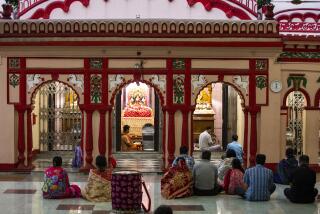Attacks put spotlight on India’s TV news
- Share via
NEW DELHI — Add another casualty to the list of victims of the Mumbai attacks: the credibility of India’s 24-hour television news channels.
In the wake of the November assault that killed more than 170 people, India’s TV channels, often accused of sensationalism, have come in for rebuke, accused of informing their viewers so quickly and completely that the alleged masterminds in Pakistan were able to tell the attackers what Indian security personnel were planning and when.
The uproar has intensified a long-simmering debate over whether the government should exert some control over coverage in the interest of “responsible” news media -- or stay clear amid fears of the censorship seen during Indira Gandhi’s period of emergency rule in the 1970s.
“I feel the media should operate under certain guidelines,” said Sonali Bhatia, 26, a teacher in New Delhi. “Then again, there shouldn’t be complete interference. Freedom of speech is essential.”
Since the mid-1990s, when regulations on India’s state-run broadcast media were first loosened and private channels allowed, the number of TV networks has grown steadily, furiously competing for eyeballs.
Last week, after protracted howls from media groups, Prime Minister Manmohan Singh signaled that the oversight role played by the Ministry of Information and Broadcasting wouldn’t change any time soon, easing broadcaster concern.
One thing that sparked criticism of the Mumbai attack news coverage was the live broadcast of a commando helicopter assault on the roof of the Nariman House Jewish center, which detractors say eliminated the element of surprise and undercut the operation.
Also under fire is the breathless tone of some reports. One correspondent appeared so agitated in her reports, one critic wrote, that “she seemed to hyperventilate on camera.”
“The media acted completely hysterically,” said author Arundhati Roy, whose novel “The God of Small Things” won the prestigious Man Booker Prize. “And it orchestrated middle-class anger against all politicians. I’m the last person to want to defend politicians, but it was a little frightening.”
Critics also point to the coverage of another story, the killing of a 14-year-old girl, Arushi Talwar, who was found with her throat slit. When her father was arrested, news channels screamed “Killer Father!” only to see him released two months later for lack of evidence.
In response to the criticism for its Mumbai coverage and to head off regulation, a recently formed group of 14 networks, the News Broadcasters Assn., released self-policing guidelines that include measures to delay broadcasts of commando operations.
But that’s hardly comprehensive, said P.N. Vasanti, director of New Delhi’s Center for Media Studies. India has 77 24-hour news channels on the air and 130 licenses approved, she said, resulting in extraordinary pressure to sensationalize, claim specious “exclusives” and do almost anything else to attract attention.
“Can you believe that number?” Vasanti said. “I can hardly sleep thinking about it.”
Newspapers and magazines tend to get far less flak than the broadcasting industry, which expanded rapidly three years ago when license requirements were eased. Because illiteracy remains high in India, some fear that the power and immediacy of television increase the risk of social turmoil in a country with caste, religious and ethnic divisions.
The Indian civic group Common Cause, which is not related to the U.S. organization, has petitioned India’s high court for more government oversight, including a content code, even as it seeks to safeguard the news media’s watchdog function.
“We feel government has a role, because self-regulation and self-governance has not been very effective,” said Kalmalkant Jaswal, the group’s director. “The coverage of Mumbai’s outrage demonstrates the inability of the media to govern itself.”
But NDTV correspondent and managing editor Barkha Dutt, sometimes referred to as India’s Christiane Amanpour, strongly disagrees.
The media are not perfect, said Dutt, one of the representatives to meet with senior government and political leaders in recent days. But the main complaint that commando operations were jeopardized has been addressed by the new industry code, she said, adding that her network voluntarily delayed some of its coverage during the attacks.
She believes Indians have been badly shaken by the violence and don’t know how to process it, venting their anger first on politicians, then bureaucrats, and now the news media. Studies also show that even as people decry entertaining or sensationalistic coverage, they don’t watch staid, serious reports.
“Everyone watched the crisis, transfixed, then hated themselves for watching,” Dutt said, adding that people always have the option of switching channels. “I’m always open to constructive criticism, but the remote control is a very powerful instrument.”
--
Pavitra Ramaswamy of The Times’ New Delhi Bureau contributed to this report.
More to Read
Sign up for Essential California
The most important California stories and recommendations in your inbox every morning.
You may occasionally receive promotional content from the Los Angeles Times.










